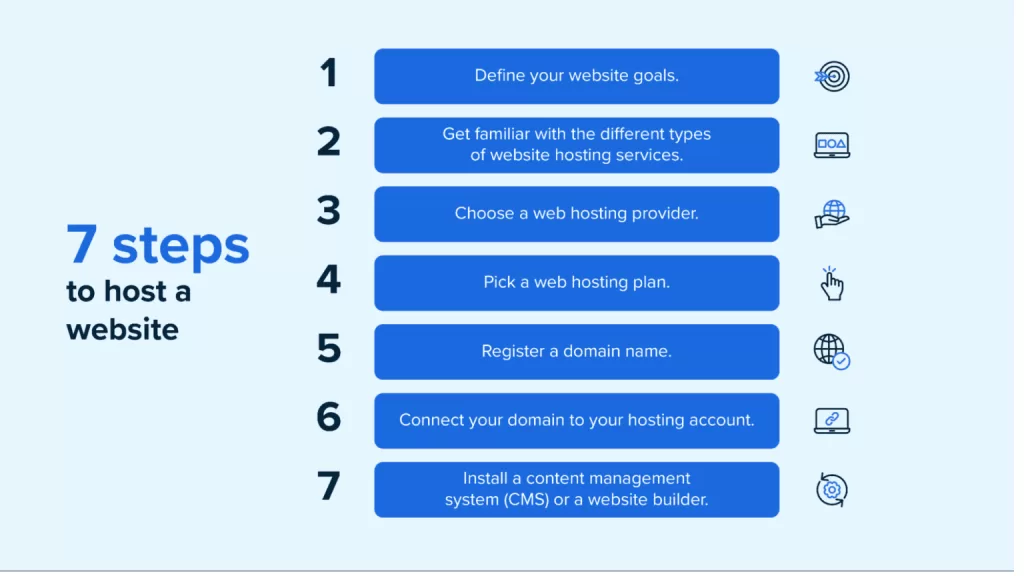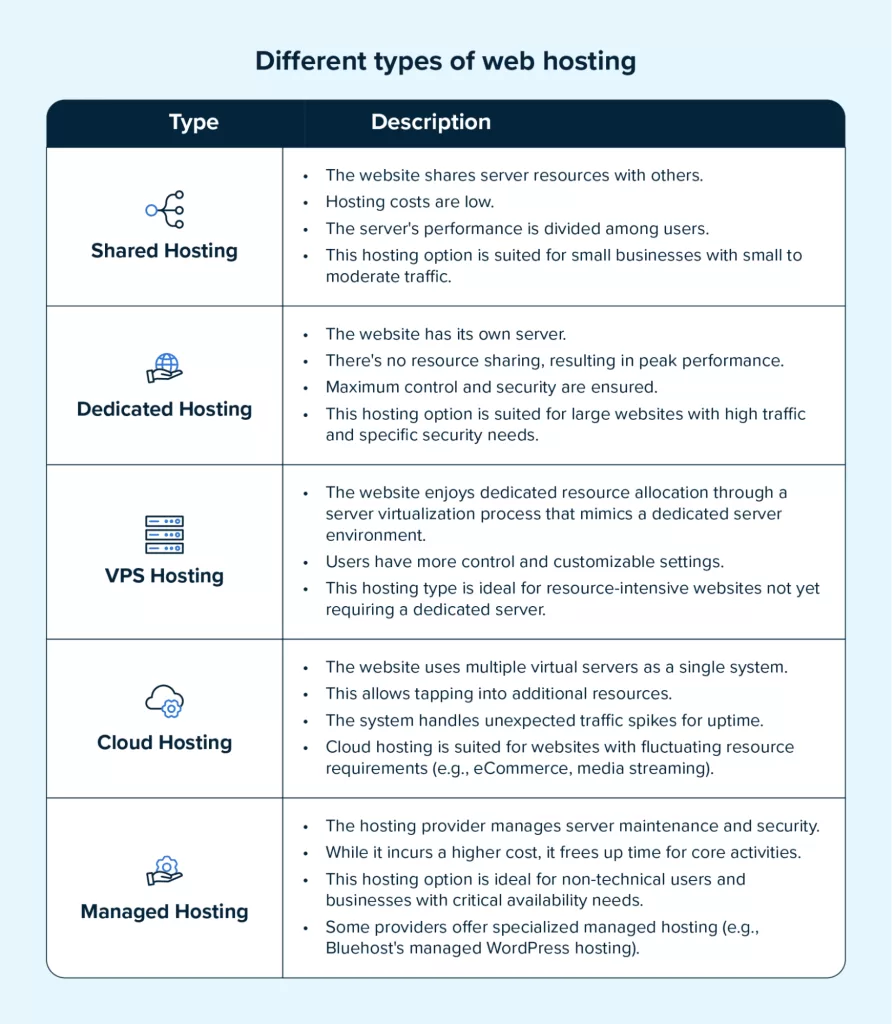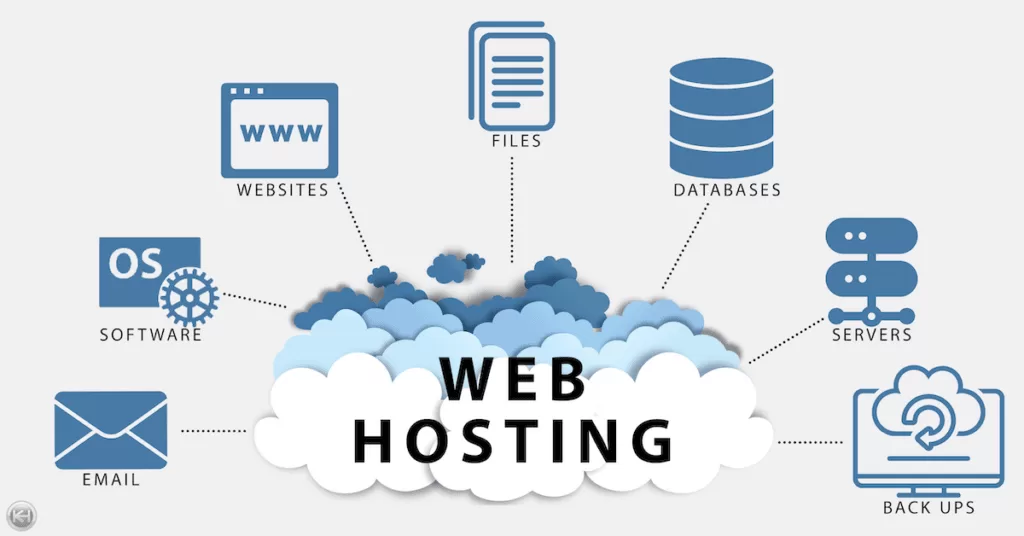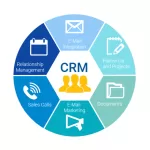How to Host a Website in 2025: A Simple 7-Step Guide for Beginners
How to host website? While the idea of hosting a website may seem complex, it doesn’t require any technical skills. With the right steps, you can set up and launch your site in minutes and learn how to host a website.
Web hosting services are essential for getting your website online. They ensure your pages are accessible to everyone on the web.
However, choosing the right hosting can seem overwhelming. Making the wrong choice can lead to performance issues, limit your site’s growth, and increase costs.
To help you, we’ll cover the steps of hosting a website and give you tips on selecting the best web hosting services for your needs.
What is web hosting?
Web hosting is a service that allows you to make your website accessible online.
When you host a website, all web files are stored on a computer system called a web server . This web server acts as an intermediary that connects your device to the user’s browser.
In other words, the web server allows users to access and communicate with your website. Your hosted website will be assigned an IP address , a unique identifier that facilitates the connection between users and your web server.
However, you don’t want users to have to type their entire IP address into their address bar to access your website. Instead, they can visit your website by typing in a domain name associated with it.
Web hosting can seem complicated if you’re a beginner. But you don’t need to be a techie to host your own website, unless you opt for self-hosting, which involves setting up your own web server.
Website Hosting Options
How to host website? Hosting a website might not seem like an easy task. Basically, you have the following options:
- Host your website yourself from your server at your office, business, or home.
- Use a specialized web hosting solution .
Below, we’ll review these two options and detail the steps you should follow so you have a better idea of which option is right for you.
How to host your website?
Local hosting on your computer
How to host your website?
First, to host a website locally on your computer , you need to determine what your operating system is .
If you have a Windows system , the steps to follow are as follows:
Download WAMP
WAMP stands for Windows, Apache, MySQL, and PHP. These unusual names are actually the components of your future personal server.
You can, for example, download the free program WAMPServer, although there are others.
Indicate your website
Once the WAMP server is downloaded, you must tell it which website to host. Therefore, code your website in advance using HTML with a .php extension and integrate the files into your personal WAMP server.
You must do this coding in advance so that you are prepared when hosting the site.
Make your website visible
After downloading all the HTML files, your website will be private by default. Obviously, it won’t be visible to anyone other than you.
Therefore, you can change the coding and adjust the structure before making it public. Once you’re satisfied with the site’s appearance, all you have to do is make it publicly visible.
If you have a Linux system , the steps to follow are as follows:
Download LAMP
You guessed it, LAMP stands for Linux, Apache, MySQL, and PHP. Clearly, it follows the same principle as WAMP, but for a Linux operating system.
Just keep in mind that you’ll need your MySQL login and password details when installing the program.
Download the site files
Just like for Windows, you must have your website’s HTML files on your personal server software.
Configure Apache software
Apache allows users to access your website. Therefore, you must configure the preferences and settings for this component to make your website accessible and public.
As you’ve noticed, hosting your own website is a task that requires skill , time , and a fairly powerful computer that will be constantly on. However, this solution is free and will allow you to rely solely on yourself and your technical skills.
Now, there are specialized solutions that are also reliable and require less management . Here, we’ll show you how to host your website with a specialized solution.
What You Need to Host a Website
How to host website? Web hosting requires two essential elements:
- A domain name
- A web hosting service provider
Domain name
A domain name is a numeric address that visitors can use to identify and locate your website online.
A domain name consists of two parts: the actual name you choose (e.g., “mywebsite”) and the domain extension (e.g., “.com” or “.net”).
You can acquire a domain name through domain registrars , which are companies that specialize in registering and managing domain names. Choosing a memorable and relevant domain name is crucial to the success of your brand, as it reflects your online identity and conveys professionalism.
Web Hosting Service Provider
A web hosting service provider is a company that offers server space and resources so users can access your website over the internet. These companies host your websites in exchange for a small monthly fee.
Popular hosting platforms like Bluehost not only provide reliable hosting services but also offer a free domain name for the first year, helping you reduce the startup cost of your new business.
How to host a website
Learning how to host a website is much easier than it looks, especially if you follow the right steps.
Here’s a step-by-step tutorial to help you get started:

1. Define your website’s goals
To properly host your website, first define its main objectives.
You need to clarify the purpose of your website. Do you want to establish a presence with blog posts or create an e-commerce store to sell products? This is crucial. This step helps you find the hosting features needed to achieve your goals.
The first step in creating a website is deciding whether it should be static or dynamic. A static website displays the same content to all users. It’s ideal for personal blogs, portfolios, event pages, and resumes.
Static websites require fewer resources, so you can often start with a basic hosting plan and upgrade as your site grows.
In contrast, a dynamic website adapts content based on user location and behavior. This is best for e-commerce, membership sites, streaming services, and web applications. Dynamic sites require more flexibility and power, so you’ll need a hosting plan that can support them.
Once you know what type of website you want to build, it’s easier to estimate the resources needed to run it well. From there, you can select a hosting plan that aligns with those needs.
Most hosting providers, like Bluehost, offer options for both static and dynamic sites. These include shared, cloud, VPS, and WordPress hosting.
2. Familiarize yourself with the different types of website hosting services
After defining your website’s goals, you should familiarize yourself with the different types of hosting services. This way, you can make decisions based on your website’s specific requirements and your level of expertise.

Shared hosting
With a shared hosting plan , your website shares server resources with other sites. While this can reduce hosting costs, it also means that server performance is spread across multiple users.
Shared hosting can slow down your website, especially during periods of high traffic or when other websites on the shared server are experiencing traffic spikes. Due to its affordable price, this hosting plan is suitable for small businesses with moderate traffic.
Virtual Private Server (VPS) Hosting
VPS hosting involves hosting your website on a virtualized server that gives you more control than shared hosting. This hosting environment allows you to customize settings and install specific software, making it a logical upgrade for businesses that have outgrown their shared hosting plans.
VPS hosting is a great option for resource-intensive websites that require a higher level of control, but don’t yet warrant a dedicated server.
Dedicated hosting
In a dedicated hosting environment , your website has its own server. Because you have exclusive access to the server’s resources, your website can operate at optimal performance.
This setup also offers full control and maximum security, making it suitable for high-traffic websites and resource-intensive web applications that must comply with specific security regulations.
Cloud hosting
Cloud hosting uses multiple virtual servers that work together as a single system. With this setup, your website can tap into additional resources as needed. This allows your website to handle unexpected traffic spikes while ensuring excellent uptime.
Cloud hosting is suitable for websites with varying resource requirements, such as large e-commerce sites and media streaming services.
Managed hosting
With managed hosting, the hosting provider handles the technical aspects of running a website, from server maintenance to security updates. While this hosting plan is more expensive than the other options we’ve highlighted, it allows you to focus on core business activities, leaving the technical details to your host.
Managed hosting is not only ideal for non-technical users, but also for business websites that require critical uptime, top-notch security, and optimal performance.
Note that some web hosting providers have specific types of managed hosting. For example, Bluehost offers managed WordPress hosting , which provides everything you need to easily create a WordPress website.
3. Choose a web hosting provider to How to host website?
Now that you have a general understanding of your website needs and the types of hosting plans, your next step is to choose a web hosting provider.
With countless options available, choosing a web host can be difficult, especially if you’re a beginner. You may need to compare several companies to find the one that best suits your needs.
To make the right choice, here are five key considerations when choosing a web hosting provider:

- Uptime: Website downtime not only results in missed revenue opportunities but also tarnishes your brand reputation. Choose a web hosting company with at least 99.9% uptime to avoid interruptions and strengthen your credibility.
- Support: Make sure your web hosting provider has accessible customer support and can offer quick resolution whenever your website encounters issues.
- Features: Choose a hosting provider that offers all the features you need to support your website’s goals. This may include sufficient storage space, bandwidth, professional email accounts, and compatibility with the technologies or applications you plan to use.
- Scalability: You need a hosting provider that allows you to increase server resources as your website grows. This is crucial if you anticipate increased traffic or plan to expand your website’s functionality.
- Security: Protecting sensitive data and providing a secure browsing experience is essential if you want to gain the trust of your target market. Choose a web hosting company that offers robust security features, including firewalls, SSL certificates, and malware detection.
In addition to these considerations, look for customer reviews on platforms like Trustpilot , G2 , and HostAdvice . After all, what better way to evaluate a web hosting provider’s performance than through the experiences of users who share your pain points?
4. Choose a web hosting plan
Many web hosts offer different hosting plans to suit different user types. If you’re on a budget and launching a website for the first time, it makes sense to choose shared hosting.
While it doesn’t offer as much resources, bandwidth, and storage space as dedicated hosting, it can meet your website’s needs while helping you reduce costs.
As your business grows and attracts more web traffic, you’ll want to upgrade to a higher-tier shared hosting plan. When your website eventually attracts a massive audience, you may want to explore dedicated hosting.
Dedicated hosting, like that offered by Bluehost, provides an entire server exclusively for your website. This is ideal for resource-intensive websites that require optimal performance and complete control.
5. Register a domain name for Host a Website
Securing your domain name is a crucial step in establishing an online presence for your business. While you can purchase a domain name after purchasing a web hosting plan, you can also secure it in advance to prevent others from claiming it.
Choose a recognizable name that aligns with your website’s content or business goals. This way, your target audience can easily remember your domain name when they want to visit your website.
Your domain name will be your website’s permanent address on the internet, so choose wisely.
To officially own and manage your chosen domain name, you must first register it through a domain registrar. While .com is the most common domain extension, consider other top-level domains (TLDs) such as .net and .org.
You can also opt for industry-specific extensions depending on the nature of your website. This allows you to choose from several options if the desired .com domain is not available.
6. Connect your domain to your hosting account
If you purchase your domain name and hosting plan from the same provider, linking your domain to your hosting server is easy. Simply enter your desired domain name during signup, complete the registration, and the provider will automatically connect your domain to your hosting account.
However, if you purchased your domain from a separate registrar, you will need to manually update the domain’s Domain Name System (DNS) settings:
- Log in to your domain name registrar account.
- Go to the DNS Management or Settings section.
- Enter the DNS information provided by your hosting provider, which is usually found in your hosting account or welcome email.
After updating your DNS settings, it can take up to 48 hours for the changes to propagate across the internet. Once completed, visitors can access your website by entering its URL into their browser, officially connecting your domain to your hosting account.
7. Install a content management system (CMS) or website builder
Now that you’ve connected your domain to your hosting account, it’s time to create your website. This is where your web development skills come into play.
But you don’t need to build a website from scratch. Regardless of your level of expertise, you can create, manage, and update your website using a CMS or website builder. Beginner-friendly options include WordPress , Wix , and Drupal .
Most hosting providers offer one-click installations for popular CMS platforms, simplifying the setup process. However, you may not benefit from this feature if you opt for a free web hosting service.
Free or paid web hosting: how to choose
Choosing between free and paid web hosting is one of the most difficult choices you’ll make when deciding how to host a website.
If you’re on a budget, chances are you’ll be tempted to choose a free web hosting service. However, while free web hosting gives you more money to spend, it could cost you more down the line.
Before signing up for free web hosting, consider these limitations that may impact your website’s performance:
Limited resources
Free web hosting offers limited server resources, which means less storage space, bandwidth, and computing power. If your website starts to grow and experiences traffic spikes, it may slow down or become temporarily unavailable due to insufficient resources.
On the other hand, paid web hosting offers more generous resources, making your website more capable of scaling as your website grows.
Limited support
Free hosting services don’t offer much in the way of customer support. If you run into problems with your website or have questions, customer service may take a while to respond, if at all. This isn’t the case with paid hosting, which generally offers more responsive and helpful customer support.
For example, Bluehost offers 24/7 live chat and phone support , ensuring you get fast assistance and expert advice whenever you need it.
Security issues
Free hosting services may not prioritize security features as much as their paid counterparts. This could leave your website vulnerable to cyberattacks, such as malware intrusion and unauthorized access.
Paid hosting often includes robust security measures (e.g., regular backups, SSL certificates, and advanced firewalls) to keep your site safe.
Paid services can cost you a little each month. But with data breaches costing an average of $4.45 million worldwide in 2023, the potential savings you gain from avoiding security breaches are well worth the investment in the long run.
Limited features and customization
Free hosting plans typically offer limited features and customization options. If you have specific requirements or want to use advanced tools and applications, a paid hosting plan is your best choice, as it offers more flexibility and a variety of features to meet your needs.
Low operating time
Uptime is a critical metric for any website owner. After all, outages frustrate users and damage your brand’s reputation.
Did you know that 60% of outages result in total losses of at least $100,000? This shows why you should prioritize web hosting providers with a proven track record of high uptime.
Unsurprisingly, free hosting providers don’t guarantee high uptime rates, which can lead to frequent downtime. Paid hosting services often offer better reliability and high uptime, ensuring your website is always accessible.
As with most free services, there’s always a catch. In the long run, it’s better to pay a small monthly fee if you’re getting real value. Additionally, many reputable web hosting providers offer cost-effective services that give you value for your money.
Tips for choosing a web host
Choosing the right web hosting service is essential to support your site’s growth while staying within your budget. Here are seven tips to help you find the perfect host.
Prioritize reliable performance
With approximately 80% of users leaving websites that take longer than four seconds to load, reliable performance is essential. A slow website can affect everything from user retention to conversion rates to SEO rankings.
Page speed is a proven ranking factor for Google, meaning slow sites often rank lower in search results. To evaluate a web host’s performance, consider the following:
- Time to First Byte (TTFB) : This measures how quickly a server responds to an initial request. Aim for a TTFB of less than 200 milliseconds for optimal responsiveness.
- Component load time : Indicates how fast cached content loads, which should happen in just a few milliseconds.
Using a website testing tool like GTmetrix is a convenient way to assess performance. GTmetrix measures multiple metrics to provide a comprehensive view of a website’s speed.
For example, one of Bluehost’s customers achieved a top rating from GTmetrix with a performance score of 98%.
Pay attention to safety measures
Cyberattacks pose a constant threat to websites of all sizes, and their frequency continues to increase every year. Protecting your website by hosting it on a secure server is essential to avoid these risks.
A reliable hosting provider should follow robust security practices. Here are some key measures to consider:
- Backups : The host should regularly store secure copies of your website files, making them accessible at any time for recovery.
- SSL Certificates : This protocol encrypts data between your site and visitors, ensuring secure transactions and protecting personal information.
- Web Application Firewall (WAF): A WAF monitors and blocks malicious traffic to protect your site’s applications.
- Regular software updates : Keeping software and plugins up to date helps close potential security holes that attackers can exploit.
- Network Monitoring : 24/7 network monitoring helps detect suspicious activity before it affects your site.
- Antivirus and malware scanning : Every file uploaded to your server should be scanned, and you should have tools to identify and remove potential threats.
- DDoS Protection: Effective DDoS prevention can prevent malicious actors from overwhelming your site with traffic, thus avoiding crashes.
- Access restrictions : Secure access via protocols such as SSH, along with IP address safelisting and file permissions, ensure that only authorized users can manage your site.
For example, all Bluehost plans include a free SSL certificate, regular backups, access control, DDoS protection, and a 99.9% uptime guarantee. Bluehost also uses SiteLock and CodeGuard to monitor and secure its servers.
By choosing a provider with these measures, you will have peace of mind knowing that your website is well protected.
Look for 24/7 customer support
A top-notch hosting provider offers 24/7 customer support through various channels, such as live chat and email, which is essential if you encounter unexpected issues such as slowdowns, site crashes, or security issues.
It’s also helpful if your web host provides self-help resources, such as tutorials or a YouTube channel, for users who prefer to learn independently.
Additionally, having access to an extensive knowledge base is invaluable. For example, Bluehost’s knowledge base offers quick solutions to common issues and serves as a learning center for users looking to deepen their understanding of web hosting.
By choosing a provider that offers comprehensive support, you ensure that you always get help when you need it.
Ensure the scalability of the host
As your website grows, it’s essential to have a hosting provider that supports easy scalability. Scalable hosting allows you to increase resources and features as needed, promoting sustainable growth over time.
For example, some providers, like Bluehost, offer multiple tiers in their shared hosting plans. This way, website owners can upgrade their plans incrementally before moving on to more robust options, such as VPS or cloud hosting, as their site’s demands increase.
Choosing a web host with flexible scaling options ensures your website can grow seamlessly.
Final thoughts
Hosting a website can seem overwhelming. But you can streamline the process by breaking it down into smaller pieces. By defining your specific goals and requirements from the start, you can create a professional website that builds brand credibility.
Whatever your website goals are, you need a hosting infrastructure that can help you achieve them.
That’s where Bluehost comes in. We offer a variety of hosting plans, ensuring you get the hosting environment your website needs. Add to that our 24/7 support, 99.98% uptime, and robust security features, and you have a hosting environment that sets your business up for success.
Start your web hosting journey off right with our hosting plans today.
Frequently Asked Questions
What is web hosting and why do I need it?
Web hosting is a service that allows you to store your own website files on web server software, making your site accessible on the Internet. A web hosting provider provides the server space, technology, and services needed to run your website. Without web hosting, your website would not be available for others to view online.
What type of web hosting is best for beginners?
Shared hosting is often recommended for beginners due to its affordability and ease of use. It doesn’t require extensive technical knowledge, as the host handles server maintenance and management. As your small websites grow, you may consider upgrading your web server to VPS or cloud hosting for more resources and control.
Can I host multiple websites on one hosting account?
Yes, many web hosting providers offer plans that allow you to host multiple websites on a single account. This is especially useful if you manage multiple sites or plan to do so in the future. Be sure to check the hosting plan specifications to ensure it supports multiple domains and provides adequate resources for all your sites.
Do I need technical skills to manage my own website?
While having some technical knowledge can be beneficial, it’s not necessary to manage your own website. Many hosting providers offer user-friendly website builders and content management systems like WordPress, which simplify the process of creating and managing websites. Additionally, providers often offer 24/7 customer support to assist you with any technical issues.
What is a domain name and how do I register one?
A domain name is your website’s address on the internet. It allows users to easily access your site. You can register a domain name through a domain registrar or your web hosting provider. When choosing a domain, consider choosing one that is memorable, reflects your brand or content, and uses an appropriate extension like .com, .net, or .org.






